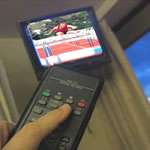Virtual Olympic Games

Viewers of future Olympic Games will enjoy the marriage of two entertainment industries – sports television and sports computer games – when a highly immersive and fully interactive TV system being developed by the IST project PISTE comes to life.
PISTE represents the most advanced and immersive interactive sports television experience created to date. Using digital video processing, computer vision, 3D-visualisation and animation techniques, the PISTE system will eventually allow viewers to watch sports events almost as if they were in the arena, while adding capabilities that promise to make a seat in front of the TV even better than a seat in the stand.
"Viewers can move around the sports arena virtually, they can watch events from different angles, replay different scenes, gain interactive information and create their own races through applying 3D graphics to real footage," explains project coordinator Thanos Demiris at Intracom Hellenic in Greece. "It's a completely new experience, merging what we are accustomed to seeing on TV with what is offered by sports computer games."
Beyond state-of-the-art iTV
PISTE takes the current state-of-the-art of interactive TV a step further, providing not only new ways to watch sports but also ways to participate virtually and interact with what is going on.
"Take for example a race between eight athletes, in which your favourite runner is not competing. With PISTE you could add a ninth runner virtually, an avatar who would race alongside the rest and allow you to compare performances," Demiris says. "The avatar could be based on the best race of your national, European, world or Olympic champion - so long as that information is in the system."
The same feature would also allow users to create virtual competitions, combining the performances of the winners of semi-final races to view the possible outcome of the final.
PISTE, however, has many other elements, some of which Swiss project partner Dartfish introduced into the project and which it is commercialising for the Athens Olympics. With the StroMotion system, viewers of the company's client channels will be offered the possibility of watching athletes with a stroboscopic effect applied, whereby a long-jumper or high-jumper would leave a trace behind them to show the stages of their jump. The SimulCam feature will also be employed for the Olympics, permitting viewers to see the performances of multiple athletes on the screen at the same time.
The full PISTE system also offers a high-degree of personalisation, allowing users to select their preferred events and athletes, and receive additional information geared specifically to their interests.
"Obviously all these features allow viewers to analyse performances themselves, something that is much more appealing than the tables of statistics shown on conventional television," Demiris notes.
PISTE provides in-depth, interactive on-screen information, something which, combined with the virtual visualisation capabilities, has been highly valued by trial users, among them sports fans and average TV viewers alike.
A cost effective solution for broadcasters
But what would be the cost for broadcasters of employing such an advanced system? Relatively little, Demiris says, once the competitive advantages it provides are taken into account.
PISTE was designed to be low cost, and its use of PC-based software for pre-processing information before the start of an event eliminates the need for costly sensors to be added to video cameras in the arena. It is a pioneering methodology, combining MPEG-4 and MPEG-2 content along with MPEG-7 information to provide real-time enhanced footage over satellite and cable to users' Set-Top Boxes (STBs).
"Producers and video engineers work together before a soccer match or athletics competition to compile images of the stadium and construct 3D models, then when the event begins there are very few variables that need to be changed or new elements, such as the athletes themselves, incorporated, allowing enhanced images to be broadcast in real-time," Demiris notes. "This obviously provides broadcasters with a major advantage over their competitors in that they can provide many features and interactive information at relatively little cost."
Nonetheless, cost does remain a factor in the interactive TV market, due principally to the high price tag on the STBs required for such a system to operate in full.
"STBs capable of hosting the PISTE features currently would cost around 1,000 euros and that is prohibitively expensive," Demiris explains. "But the cost of the graphic cards they contain is falling and so too should the price of the boxes. Once they get down to around 400 euros or 500 euros STBs will become more common."
The project coordinator indicates that that will occur within two to three years, more or less the same time in which he expects a full-blown commercial version of PISTE to take off across Europe in what, he predicts, will be a "huge market."
"Many websites already offer interactive information and analysis," Demiris notes, "it will only be a matter of time before people start demanding that from their TV sets."
Source: Based on information from PISTE
















